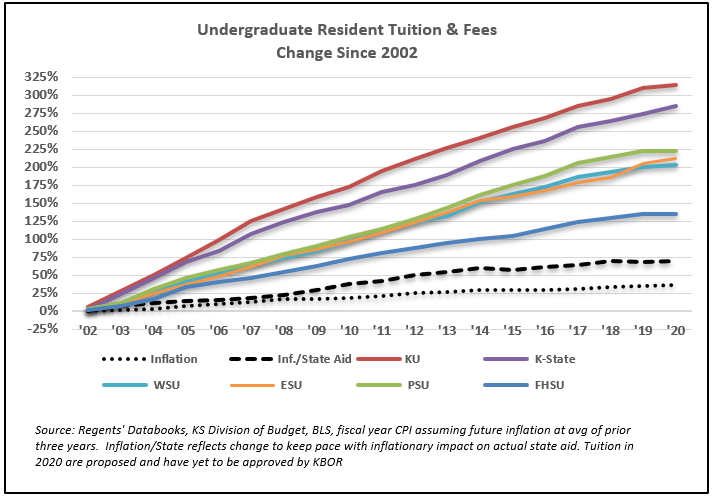Kansas students are suffering financially from the accelerating cost of college. If policymakers truly seek to provide tuition relief, they should realize state aid has little to zero effect on tuition hikes.
The idea that education needs more state funding strongly influences Kansas policy. To that degree, the legislature approved an extra $33 million in state spending for higher education. Governor Kelly expressed hope the additional funding would lead to lower tuition rates. Too many Kansas students are racking up staggering debts because of the skyrocketing cost of college tuition.
The Governor makes a great point. According to the Institute for College Access & Success, 59% of graduates from Kansas universities are saddled with debt. This puts Kansas with the 17th highest student debt ranking in the country. The growth in tuition at the six state universities seems to double every 8 years.
State funding for 2020 is set to reach $424 million, or 4.5% higher than 2002 levels, for Kansas Regents Institutions – KU, KSU, WSU, Fort Hays, Pitt State, and Emporia State. Over the same time, inflation is 44.1% over 2002 levels.
 In the chart above, we noted tuition and fee changes since 2002. The darkest dotted line is where state aid to universities should be, if accounting for inflation. All the colored lines represent the change in tuition and fees for each state university. For KU, their tuition and fees will be 313% higher from 2002 to 2020. Meanwhile Fort Hays State University’s tuition has the slowest growth over the time frame, near 136%. Unfortunately, every state university in Kansas is raising tuition far faster than state aid growing at inflation.
In the chart above, we noted tuition and fee changes since 2002. The darkest dotted line is where state aid to universities should be, if accounting for inflation. All the colored lines represent the change in tuition and fees for each state university. For KU, their tuition and fees will be 313% higher from 2002 to 2020. Meanwhile Fort Hays State University’s tuition has the slowest growth over the time frame, near 136%. Unfortunately, every state university in Kansas is raising tuition far faster than state aid growing at inflation.
Critics may see this yet argue that lower levels of state funding has led to rising tuition as an attempt to maintain university income. Therefore, increasing state aid must lead to tuition relief for Kansas students. It is true state funding dropped in 2009. However, the pace of tuition growth before 2009, and after 2009 , is virtually identical. The fact that tuition growth looks more like a straight, upward-sloping line with little kinks says state funding may have little effect on tuition. In other words, today’s high tuition would be present in spite of a higher state spending commitment.
Polling suggests everyday Americans are aware of the futility in state funding and changes in tuition rates. A nationwide poll conducted in August 2018 by Boston Public Radio found that Midwest residents oppose paying higher taxes for more state funding of universities by a margin of 13 percentage points. Not only does higher state funding have little effect on tuition changes, but fewer Americans are willing to raise their taxes to even try. The logical alternative is for state universities to lower costs.
One way is for universities to offer more online programs. The cost of a virtual educational experience tends to be cheaper than traditional methods. It expands educational resources to more students, putting some downward pressure on tuition. In fact, perhaps this is why tuition rates at Fort Hays State University are substantially lower than its Kansas peers. Its Virtual College program is known as the best online degree program in Kansas and is ranked second in the nation.
Another option is offering alternatives to student loans, like an Income-Share Agreement (ISA). This model was first theorized by economist Milton Friedman. An investor pays for a student’s education in exchange for a small percentage of the student’s future earnings over some time. Students who earn little in earnings after graduation pay a smaller share than those students who find high earnings. An ISA is a tool to relieve the growing burden of student debt.
To its credit, the federal student loan program has repayment tools too. However they are numerous, some are complicated, and not all are known by students. An ISA uses the same repayment structure. The relative ease in an ISA makes the cost of college more transparent. As an example, if more students are better informed about the cost of college and their ability to repay it, then fewer students may choose majors with low-earning potentials. ISAs encourage students to make better decisions in which schools to attend and the majors to focus on. The state university Purdue is the largest school with this program. They estimated their students of average post-graduation incomes pay back 1.5-1.6 times the loan they received. In part thanks to this program, Purdue University is in its 8th year of a tuition freeze.
A four year college degree should be more accessible for the students who wish to pursue it (and a non-college education can be a terrific option as well). However, failing to examine alternatives means tuition growth doubles every 8 years with no end in sight. Solutions are out there that balance the needs of educational opportunity and affordability. Throwing more state aid at universities has, thus far at least, failed to achieve such a balance.




